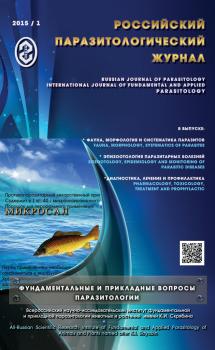Protostrongyloses are widely-spread in small cattle all over the world and may cause a significant economic damage manifested in decrease in livestock productivity as well as death of animals. Based on our studies, the infestation of sheep and goats with protostrongylides was detected in all landscape zones of the republic of Armenia and in animals of all ages. As a rule, the protostrongylide invasion rate of goats is higher than of sheep. Within the republic, the average invasion extensity in goats of different age groups ranges between 20,4 and 44,1%, and in sheep — between 16,5 and 37,0%. In some stationary invasion foci, more than a half of livestock suffers through protostrongyloses. The highest protostrongylide invasion was found in animals older than 3 years of age, and the lowest — in animals of the first year of life; it means that the invasion increases with the age. The invasion of animals in mountains is higher in comparison with animals from plain areas. The peak of invasion falls on autumn and winter seasons. Taking into account a high level of protostrongylide invasion in small cattle in the republic of Armenia, and the unavailability of guidelines on this infectious disease, we have developed (based on the long term investigation of more than 3000 head of animals) methodical recommendations for the struggle against protostrongyloses. The implementation of these measurements proved their high efficacy and contributed to the significant reduction in morbidity of small cattle due to protostrongyloses.
Сведения о протостронгилидозах и их возбудителях
Протостронгилидозы — это большая группа легочных гельминтозов животных, вызываемых нематодами подотряда Strongylata Railliet et Henry, 1913, семейства Protostrongylidae Leiper, 1926. В Армении возбудителями протостронгилидозов (мюллериоз, цистокаулез, протостронгилез) домашних овец и коз являются 6 видов нематод Muellerius capillaris,Cystocaulusnigrescens, Protostrongyluskochi, P. hobmaieri, P. muraschkinzewi, P. davtiani[5, 8, 12]. Кроме домашних овец и коз к окончательным хозяевам протостронгилид относятся также некоторые виды диких жвачных [13]. Так, в легких безоаровых коз республики выявлено паразитирование М. capillaris, С. nigrescens, Р. davtiani, Р. muraschkinzewi, Р. kochi[4], а муфлонов — С. nigrescens, Р. davtianiи М. capillaris[6].
1. Abuladze K.I. et al. Parazitologiya i invazionnye bolezni sel’skohozyaystvennyh zhivotnyh. [Parasitology and invasive diseases in farm animals]. M., Kolos, 1975. 472 p. (In Russian)
2. Boev S.M. Osnovy nematodologii. Protostrongilidy [Essentials of Nematodology. Protostrongylids]. M, Nauka. - 1975, vol. 25. 207 p. (In Russian)
3. Boyahchyan G.A., Therapeutic efficacy of Alben against lung and gastrointestinal strongylatoses in sheep. Izvestiya Gos. agrarnogo un-ta Armenii. [Bulletin of the State Agrarian University of Armenia]. Yerevan, 2009, no. 1 (25), pp. 48-51. (In Russian)
4. Boyakhchyan G.A. Methods of lifetime diagnostics of lungworms in sheep and goats in expedition conditions. Ross. parazitol. zhurn. [Russian Journal of Parasitology], 2007, no. 2, pp. 122-124. (In Russian)
5. Boyakhchyan G.A. Legochnye nematody i nematodozy ovec v Armenii (rasprostranenie, invazirovannost’, mery bor’by s diktiokaulezom). Diss. dok. biol. nauk [Lung nematodes and nematodoses of sheep in Armenia (prevalence, invasion, struggle measures against dictyocaulosis). Diss… doct. biol. sci.]. Yerevan, 2010. 211 p. (In Russian)
6. Grigoryan G.A. Parasitic worms in bezoar goats in Armenia. Tr. Arm. NIVI [Proc. of Armenian Scientific Research Veterinary Institute]. Yerevan, 1949, i. 6, pp. 151-158. (In Russian)
7. Grigoryan G.A. On the study of the helminth fauna in Armenian mouflons (Ovis ophion armeniana) in the Armenian Soviet Socialist Republic. Izv. AN ArmSSR. Erevan [Bulletin of the Academy of Sciences of the Armenian SSR].Yerevan, 1951, vol. 4, no. 9, pp. 821-826. (In Russian)
8. Davtyan E.A. Development cycle of lungworm Muellerius capillaris in sheep and goats. Erevan. Tr. Arm. NIVI [Proc. of Armenian Scientific Research Veterinary Institute]. Yerevan, 1937, i. 2, pp. 41-97. (In Russian)
9. Movsesyan S.O., Boyahchyan G.A., Chubaryan F.A., Petrosyan R.A., Nikogosyan M.A., Arutyunova L.D., Panayotova-Penchev M.S., Bankov I., Demyashkievich A.V., Mal’chevski A. The role of mollusks in formation of biological diversity of lung nematodes Protostrongylidae in animals. Ross. parazitol. zhurn. [Russian Journal of Parasitology], 2010, no. 3, pp. 43-60. (In Russian)
10. Movsesyan S.O., Boyahchyan G.A., Chubaryan F.A., Petrosyan R.A. Effect of the phytopreparation Loshtak on the immune status of lambs in experimental dictyocaulosis. Diff. diagnostika parazitov i aspekty parazito-hozyainnyh otnosheniy [Differential diagnosis and aspects of host-parasite relationship]. M., 1994, pp.13-19. (In Russian)
11. Movsesyan S.O., Petrosyan R.A., Boyahchyan G.A., Chubaryan F.A. Effect of the yeast low-molecular RNA on the values of non-specific resistance of lambs in experimental dictyocaulosis. Veterinariya [Veterinay Medicine], 1996, no. 11, pp. 25-27. (In Russian)
12. Savina N.V. On the study of causative agents of synthetocaulosis in sheep and goats in the Armenian Soviet Socialist Republic. Tr. Arm. NIVI [Proc. of Armenian Scientific Research Veterinary Institute]. Yerevan, 1940, i. 3, pp. 44-45. (In Russian)
13. Samoylovskaya N.A. Ecology of helminths in wild ruminants in Losiny Ostrov National Park. Rossijskij parazitologicheskij zhurnal [Russian Journal of Parasitology], 2013, no. 3, pp. 45-49.
14. Chubaryan F.A., Petrosyan R.A., Arutyunova L.D. Efficacy of Alben and Atasol Forte against lungstrongylatosis in sheep. Mat. regional’n. nauchn. konf., posvyashh. 60-let. In-ta zoologii NAN RA «Issledovanie i okhrana zhivotnogo mira Yuzhnogo Kavkaza» [Proceedings of the regional scientific conference dedicated to 60th anniversary of the Institute of Zoology, NAS of Armenia «Research and protection of wildlife in the Southern Caucasus»]. Yerevan, 2003, pp. 38-39. (In Russian)





